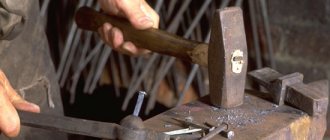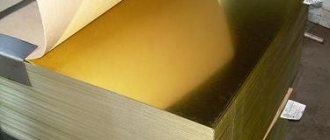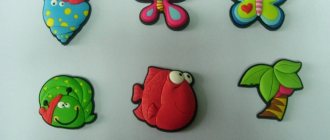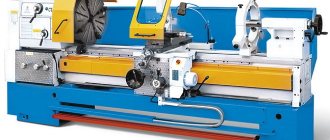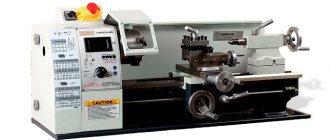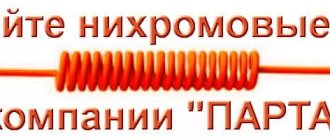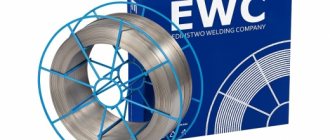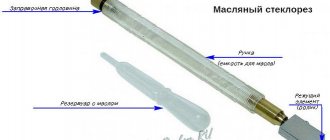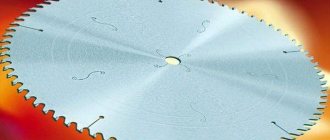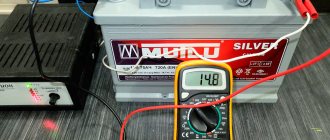It all started with an acquaintance offering me to buy a used lathe at the price of scrap metal, since at the enterprise where he worked, reconstruction and re-equipment of production was in full swing, so almost all the equipment was replaced with modern equipment, and the old one was sold or melted down.
The offer is very tempting for me, since I have long dreamed of starting my own business in this field. And there were prerequisites for this - higher technical education and several years of work at a metalworking enterprise.
I decided that I could independently organize a business in this area and make more profit than at the factory.
This is the story of my reader Evgeniy S. Today he will tell you about how he opened a metalworking shop from scratch and what came of it.
Marketing and action plan
Knowledge and experience allowed me to start by organizing a small production of metalworking and piece production of component products in the field of mechanical engineering.
But I didn’t know what exactly to produce. There were a lot of ideas, ranging from making bolts and nuts to complex structures.
Having carried out, so to speak, a quick review of the market for metalworking services in my own and surrounding regions, I was convinced of the following: everything that I could produce is already being successfully sold by other companies and in such volumes that it will be economically competitive with them unprofitable.
Nevertheless, I decided to start, and see where the curve leads. I decided to focus my business promotion on creating my own website.
WATTSAN series machines for home workshop
- Cutting hard minerals, natural stones (granite, marble edges), metals (steel, ductile iron, copper, titanium).
- Making complex shapes, engravings, cutting.
- 3D milling.
- Processing of wood, board material, gypsum, concrete, tiling.
- Cutting acrylic, plexiglass, PVC, PP, PE materials.
- Processing of a composite product (engraving, cutting out figures).
- Working with soft metals: aluminum, lead, tin, copper.
You can also check out other business plans for organizing a business in a garage
Sequence of idea implementation
Having set this goal for myself, I began to implement it in the following way:
- Since I didn’t have money, I decided to take out a loan. I decided on the required amount and submitted an application to the bank, and after a couple of days I received the required amount.
- I found a suitable premises and signed a lease agreement for it.
- I bought a lathe that a friend had offered me at the price of scrap metal, and also agreed on the further purchase of a milling machine.
- Based on an advertisement, I found a worker - a turner.
Next, I transported the machine indoors and connected it to electricity. In addition, I brought a welding machine, a grinder, a drill, in general, all the small tools that I had before. I bought several cutters and drills for the machine. As a result, without expecting it, I received a fairly equipped mini-workshop.
How to make money on a metal lathe
A widely known and popular method for producing metal parts and products for various purposes is metal turning.
During this process on a lathe, the excess layer is removed from the products, and the output is a part of the desired shape with a rough surface and the required dimensions.
Modern equipment controlled by computer-integrated devices can significantly improve the quality of the resulting products.
General information about metal turning
The metal processing procedure is carried out on special lathes using various cutting tools. The workpiece is installed in the spindle of the device , the operation of which begins after the electric motor is turned on.
The workpiece begins to rotate at high speed and a small layer of metal is removed from it over its entire surface with a cutter, drill or other cutting tool.
With the help of constant movement of the tool, the part is continuously cut to the required sizes and shapes. A more detailed process of turning a part can be seen in the video clip.
The machines allow efficient processing of various workpieces, resulting in a conical, threaded, cylindrical, shaped or other surface. With the help of turning work the following can be performed:
- rings;
- shafts;
- pulleys;
- couplings;
- gear rings;
- bushings;
- nuts
In addition, on a lathe you can:
- Make grooves.
- Cut off various parts of products.
- Process various holes using countersinking, reaming, drilling, boring.
- Cut the thread.
In the process of performing work, it is imperative to use various measuring instruments, which determine the sizes, shapes and layout options of the workpieces. In single and small-scale production, bore gauges, calipers, and micrometers are used for this purpose. Large enterprises use extreme calibers.
Advantages of metal turning
This process is considered a universal technology and is used for the manufacture of various products from alloys and metals. On a machine equipped with special-purpose cutters, even particularly hard materials can be processed.
Main advantages of the technology:
- High surface cleanliness of the resulting products.
- Processing precision.
- Possibility of producing a product with a complex configuration in one working cycle.
- The chips obtained after processing the part are melted and can be reused.
- When using special equipment, it is possible to produce large-sized parts.
In addition, with the help of turning equipment it is possible to organize mass production of products for various purposes.
Features of turning. examples
The essence of the metal processing process is as follows:
- machine movements are carried out in clear directions;
- the spindle of the device, together with the workpiece, rotates along the Z axis, which is the starting point in operation;
- the straight X axis must be strictly perpendicular to the Z axis;
- the cutters should be located in the XZ plane;
- The distance to the cutter must be adjusted when applying equipment.
In modern lathes there is a third coordinate, which is equal to the angle of the main spindle. This indicator can be set and adjusted using software.
Types of lathes
The most popular device for metal processing is the screw-cutting lathe, which is highly versatile. It is used in large enterprises, as well as in single and small-scale production.
In addition , there are other types of lathes:
- Screw-cutting lathes.
- Semi-automatic multi-cutting devices for serial and large-scale production.
- Turning-rotary two- or single-column.
- Turret lathes designed to work with complex products.
- Modern turning and milling complexes.
To produce parts with particularly precise diametrical and linear geometric parameters, programmable machines are used. In their design they are almost no different from universal ones.
Cutting tools for lathes
The efficiency of the equipment depends on the cutting speed, the amount of longitudinal feed of the workpiece, and the cutting depth. Using these indicators you can achieve:
- maximum permissible chip volume;
- stability of the tool and the required level of its impact on the workpiece;
- necessary processing of the part;
- increased spindle rotation.
The specific cutting speed depends on the type of material being processed, as well as the type and quality of cutters used.
Cutting tools for lathes can be rough or finishing. Their selection and application depends on the nature of the processing. Based on the direction of movement, they are divided into right and left. Various geometric sizes of cutters allow you to work with any area of the layer that needs to be cut.
According to their purpose, cutting tools can be:
- cut-off;
- threaded;
- boring;
- shaped;
- grooved;
- walk-through;
- trimmed.
To process the cylindrical surface and end plane, through-thrust cutting tools are used. Parting cutters are used to cut off parts of a product and make grooves. Conventional straight and bent ones are optimal for processing the outer surfaces of metal parts. Using boring cutters, previously drilled holes are bored out.
Based on the shape of the incisor and the location of the blade, the incisors are divided into bent, straight and retracted . The width of the drawn cutters is lower than the width of the fastening part.
The geometry of the cutter used has a great influence on the quality of cutting parts. With properly selected angles between the cutter edges and the feed direction, processing productivity increases. The first angle depends on the installation of the tool, the second on its sharpening.
For large cross-section products,
an angle of 30-45 degrees , and for thin non-rigid parts - 60-90 degrees.
The auxiliary angle should be 10-30 degrees. It is worth noting that regardless of what type of machine is used, the main role in turning belongs to the cutting tool. But no matter what equipment and tools the turner works with, his workplace must be clearly organized and fully equipped.
- Alexander Romanovich Chernyshov
Advertising via the Internet
Now the task was to receive orders. I decided that the best option would be to promote a business through my own website, and since I am not particularly versed in the issues of creating resources, I turned to a specialist in this field.
For this I had to pay 70,000 rubles. It turned out that the site cost me an amount equal to what I paid for the rent of the premises, the machine and the monthly salary of the employee.
However, the IT specialist turned out to be an advanced specialist in this field, and my resource was in the first positions in search engines.
This was pleasing and at the same time discouraging, since the site offered an extensive list of services related to metalworking - it also included an offer for the production of hardware, bushings and axles, shafts, hydraulic stations, repair parts for machine tools, machines and other related services.
But initially I had an idea to produce one product. Why did this happen? Yes, because I didn’t know what the market needed more and decided to post offers on the website for several positions at once.
I thought, like this at first, and then we’ll see what is in great demand, then I’ll produce it, and in the future I’ll adjust the site itself, placing a bet specifically on a certain product.
Production of busy boards
Attachments:
10 thousand rubles
This is an ideal home business format: simple technology, minimal investment and equipment, cheap materials and high demand for the product. We are talking about busy boards - educational stands for children aged 1 to 4 years, on which various objects are attached that the child can interact with (twist, knock, open, tie/untie, turn on/off, and so on). A few years ago, bodyboards made a splash in the children's goods market and are still in demand among young parents.
Anyone can create such development boards. You just need a little skill and imagination. Busy boards are made from ordinary items that can be bought at any store. The main thing is to monitor the quality of materials and come up with an original format for business boards
When choosing toys for children, parents pay attention to two parameters:
- safety and quality of the toy
- benefits and developmental function of the toy.
It is very important to think through all the details - from packaging to the quality of each detail. The price of business boards varies from 2 to 10 thousand
rubles depending on the size and filling. The most convenient way to sell business boards is through the Internet. Although you can try to donate some of the products to a children's goods store. You can read more about the production of business boards in a business format here.
results
As a result, based on the results of work for 4 months, I only managed to recoup the cost of maintaining and producing my mini workshop. Basic expenses per month:
- salary for a turner – 25,000 rubles;
- payment for rent of premises – 12,000 rubles;
- payment for electricity – 3,200 rubles;
- purchase of consumables (electrodes, welding wire, cutting discs for grinders, cutters and drills) - approximately 2,500 rubles;
- transportation costs – 2,000 rubles;
- purchase of raw materials (mainly round timber grade Steel 40X) - about 5,000 rubles.
Total approximately 49,700 rubles per month. What was received in excess of this amount, it’s a shame to say, was from 200 to 700 rubles of net profit.
And then, this amount came only from a successfully rented premises in the immediate vicinity of a truck service center, from where up to 99% of orders were received (manufacture of bushings, shafts, axles, as well as the restoration of these parts by welding and grooving).
There were only 2 orders received through the site for the entire time, for a total amount of 6,000 rubles. It was not possible to recoup the costs of setting up a business.
Devices, tools
- The workshop premises are equipped and supplemented with all available tools and machines.
- Workbenches and tables are placed in convenient places, with access to them from 2 or 3 sides.
- Woodworking, metalworking, stone cutting, its grinding is done closer to the outlet, dust suction, air mixture, and exhaust hood. Cones for removing dust and polluted air are placed above such machines.
- Welding machines and autogenous metal cutting are performed with the same safety measures.
Milling engraving, wood turning, CNC machines are practical. An additional advantage of such machines is the ability to work with natural stone.
Modifications of desktop, stationary installations, with small dimensions are convenient for small spaces.
Consequences of a poorly formulated advertising policy
Subsequently, I realized that advertising on the site several diverse offers turned out to be the wrong decision, since I had to “spread myself” in several directions when I needed to concentrate on one thing, making every effort to achieve a specific goal for this position.
There simply weren’t enough initial resources to process all of their proposals. As a result, I had to close my business.
From this experience, I concluded that any startup needs to start by offering one thing, a specific product or service, especially if you advertise through your website.
In the future, of course, when promotion has already begun, you can gradually add new offers, but at the initial stage this is very risky, especially in conditions of limited financial resources. And what do you think?
What are the features of the metal structures manufacturing business?
If there are enough consumers in the market, then a small enterprise of this type can pay for itself within the first 6 months. If the advertising campaign was not carried out on time, then you should be wary of the lack of demand for production. This will lead to a long-term return on investment.
Another important nuance in this matter is the seasonality of the business. The fact is that metal structures are in demand, as a rule, only in the warm season - from approximately April to October. In the winter months, such a business rarely generates income, so it is worth thinking about long-term orders in advance.
Despite all the peculiarities of business and the large number of competitors, this area of entrepreneurial activity in Russia is still relevant and in demand.
By the way, now is the time to develop such a business – even if you are a small enterprise. Due to the fact that large manufacturers carry out only mass production, small companies have the opportunity to advance by fulfilling non-standard, original orders.
There are quite a lot of consumers of goods in this industry in each of the segments:
How to build it yourself
A normal machine costs at least 50,000 rubles. If you assemble it yourself, this amount will be significantly reduced.
Attention. To make a homemade lathe, it is advisable to use standard drawings
There are all the dimensions of the parts and the order of assembly.
These drawings can be improved. For example, it is worth adding an emergency shutdown button, a thermal relay that protects against overheating, and a protective casing.
Selection of parts
Certain elements of the device will have to be purchased assembled, such as the motor and clamp. Some are purchased separately and ordered in workshops, where they will be made to the required dimensions. The better the steel used, the longer the machine will last.
Base
The best choice would be to use a cast frame from an old non-working machine. The stability of the unit depends on the base. As an alternative, you can weld a frame from channels or profile pipes. You cannot take wood, as it will not be able to withstand the workload.
Electric motor and transmission
For the engine, you can use a device from an old washing machine or other household appliances that have sufficient power. It is also worth considering purchasing a new engine, since the price is not too high.
It is better to use a belt drive. It is much easier to assemble. Also, when using a belt directly on the shaft, there is less impact, and this significantly increases the service life.
Master and slave centers
These two nodes are placed on the same axis. There is also a type of machines that have one leading center. The follower must be placed on the tailstock (it can be rotating or stable). The sharpened end of the bolt is suitable for manufacturing.
Technological aspects of the process
The essence of the procedure is the sequential removal of the top layer from a rotating workpiece using cutters and other tools. This produces chips, which can be more or less coarse depending on the material and feed rate, and also have a different shade - the color change occurs due to heating due to friction and oxidation.
The operator secures the product on both sides in the spindles. One of them has free rotation, that is, in fact, it is only responsible for reliable fixation, while the second is the leader. Movement is transmitted through it, and speed is also regulated.
Once the workpiece is secured, the cutting process on lathes begins. First you need to choose the right speed mode. On professional equipment, the power is quite high, but you cannot always work at maximum. For example, if the shaft is very long, then its vibrations and errors will only increase with increasing speed, which will lead to inaccuracies. The second reason to choose a mode is the type of processing, namely, roughing, roughing, semi-finishing, finishing or fine. Ideally, one part should go through all of these stages with varying feed selections as well as different cutting tools for lathes and metalworking.
When the main indicators are selected, you can proceed to installing the cutter. It can be made of different types of alloy, but it must be:
- more durable than the workpiece material and less brittle;
- always well sharpened.
Special cutting edges are used for different tasks. They are installed in a caliper that has reliable clamps, as well as an adjustable angle of rotation and tilt, that is, all the parameters for the most accurate metalworking.
Now you can start turning on the installation. The whole operation consists of correctly selected two movements:
- tool feed;
- shaft rotation.
The first movement is made by the support. It moves horizontally and vertically, and if there are runners, it can move diagonally for turning cones. This is how operations such as turning and drilling are carried out on a lathe. However, for the latter type of task, the tool (drill) must be able to rotate, and the workpiece itself will be static. The movement of this part is determined either by automation or by handles and wheels. First, the operator sets it to the starting point, checks the depth, and then turns on the device and only adjusts the position of the cutter. The caliper speed is also adjusted depending on the type, material, and tasks.
The second movement is rotational. It is produced by the workpiece. The engine, which is responsible for the feed, is located in the front beam, and there are two of them. The force is transmitted to the spindle by means of belts. Rotation has a direction and speed, but no other parameters can be specified. The main thing for a turner is that there are minimal vibrations and errors, otherwise impacts on the tool will occur.
Since the machine operates mainly at high speeds, the essence of turning lies in the rapid removal of the top layer.
Problems that can be solved this way:
- Achieving specified dimensions with high accuracy.
- Drilling holes, reaming them and countersinking, cutting internal and external threads.
- The required surface roughness depends on the accuracy class.
- Cutting work - cutting part of the shaft, trimming edges.
- Grooving.
The cutting edge separates the integrity of the turning metal by applying friction and pressure to it. A break occurs at the molecular level.
Staff
If you yourself are an experienced turner, then in principle you do not need hired employees. Just an assistant. But any young man looking for a part-time job is suitable here.
Another question is if you decide to open such a business without turning skills. In this case, it will not be easy to distinguish a professional from an amateur. To make your task easier, choose candidates who have worked as a turner for at least 3 years, and no more than 2 years have passed since their dismissal.
So, what are the requirements for turners:
- third category and higher;
- cutting tool sharpening skills;
- knowledge of the operating principles of a lathe.
Artworks are included in the price
Having made a small and modest craft using a CNC machine, many craftsmen are then ready to start collaborating with shops selling souvenirs and products that relate to arts and crafts. And this is a solid and stable income if sales markets are established.
Many craftsmen have a need to correctly evaluate a product. How much do you think you can get for a panel (carving) made from a wooden blank - the result of skillful milling, measuring 20x370x548 mm? Within 10 thousand rubles. And this is in the middle price range. And on a product 60x110, with much lower quality (the milling mark is visible), we will earn only 200-220 rubles.
For a creative person, the idea of making figurines and panels with flat or three-dimensional images (plywood, plastic, metal and even glass) on milling machines can be a reliable business.
Those who like to burn will use a pyroprinter or will work on engraving devices, creating unique images in accordance with the selected photo, making custom-made souvenirs. The duration of the technological process is 6 hours or more.
Typically, the material is within 10% of the price of the product; energy costs, film and varnish coatings, depreciation of the router and processing time are also taken into account.
For example, a good quality beech icon takes about 10 hours to cut, and after the machine is finished it takes 4-5 days. And the one who makes products of this kind knows its price.
